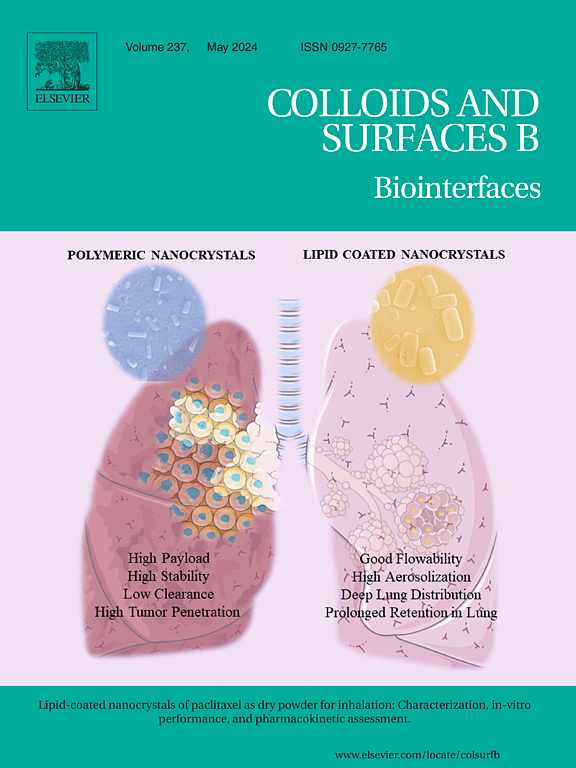Naphthalene-containing octreotide radioligand elevates selectivity and radionuclide therapy for somatostatin receptor 2-positive tumor
IF 5.6
2区 医学
Q1 BIOPHYSICS
引用次数: 0
Abstract
Peptide receptor radionuclide therapy (PRRT) with proven targeting ability has emerged as a new paradigm for clinical tumor therapy. The selective binding of octreotide to somatostatin receptor 2 (SSTR2) renders the successful development of 177Lu-DOTATATE for SSTR2-positive neuroendocrine tumor patients. Here, we find that naphthalene-containing octreotide radioligand (OCT(naph)) induces elevated tumor uptake and radionuclide therapy for SSTR2-positive tumor over DOTATATE. 177Lu-OCT(naph) demonstrated high radiochemical purity and radiostability, and increased binding affinity to human serum albumin, which led to prolonged blood circulation time and a peak accumulation of 20.8 ± 3.2 %ID/g, 1.6-fold of that for 177Lu-DOTATATE, in SSTR2+ HCT-116 tumor. A single injection of 177Lu-OCT(naph) at 7.4 MBq while induced no apparent toxicity effectively suppressed tumor growth, significantly outperforming 177Lu-DOTATATE. Overall, 177Lu-OCT(naph) with optimized albumin binding appears as a potentially better radionuclide therapy for SSTR2-positive tumors.
含萘奥曲肽放射配体提高生长抑素受体2阳性肿瘤的选择性和放射性核素治疗
肽受体放射性核素治疗(PRRT)已被证实具有靶向性,成为临床肿瘤治疗的新范式。奥曲肽选择性结合生长抑素受体2 (SSTR2),使177Lu-DOTATATE成功开发用于SSTR2阳性神经内分泌肿瘤患者。在这里,我们发现含萘的奥treotide radioligand (OCT(naph))通过DOTATATE诱导sstr2阳性肿瘤的肿瘤摄取和放射性核素治疗升高。在SSTR2+ HCT-116肿瘤中,177Lu-OCT(naph)具有较高的放射化学纯度和放射稳定性,与人血清白蛋白的结合亲和力增强,导致血液循环时间延长,峰值积累量为20.8 ±3.2% ID/g,是177Lu-DOTATATE的1.6倍。单次注射7.4 MBq剂量的177Lu-OCT(naph)在无明显毒性的情况下,有效抑制肿瘤生长,显著优于177Lu-DOTATATE。总之,优化白蛋白结合的177Lu-OCT(naph)似乎是一种潜在的更好的放射性核素治疗sstr2阳性肿瘤的方法。
本文章由计算机程序翻译,如有差异,请以英文原文为准。
求助全文
约1分钟内获得全文
求助全文
来源期刊

Colloids and Surfaces B: Biointerfaces
生物-材料科学:生物材料
CiteScore
11.10
自引率
3.40%
发文量
730
审稿时长
42 days
期刊介绍:
Colloids and Surfaces B: Biointerfaces is an international journal devoted to fundamental and applied research on colloid and interfacial phenomena in relation to systems of biological origin, having particular relevance to the medical, pharmaceutical, biotechnological, food and cosmetic fields.
Submissions that: (1) deal solely with biological phenomena and do not describe the physico-chemical or colloid-chemical background and/or mechanism of the phenomena, and (2) deal solely with colloid/interfacial phenomena and do not have appropriate biological content or relevance, are outside the scope of the journal and will not be considered for publication.
The journal publishes regular research papers, reviews, short communications and invited perspective articles, called BioInterface Perspectives. The BioInterface Perspective provide researchers the opportunity to review their own work, as well as provide insight into the work of others that inspired and influenced the author. Regular articles should have a maximum total length of 6,000 words. In addition, a (combined) maximum of 8 normal-sized figures and/or tables is allowed (so for instance 3 tables and 5 figures). For multiple-panel figures each set of two panels equates to one figure. Short communications should not exceed half of the above. It is required to give on the article cover page a short statistical summary of the article listing the total number of words and tables/figures.
 求助内容:
求助内容: 应助结果提醒方式:
应助结果提醒方式:


